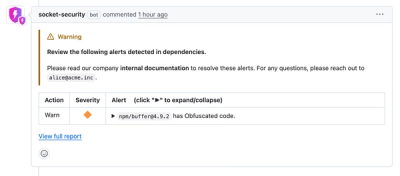
Security News
Crates.io Users Targeted by Phishing Emails
The Rust Security Response WG is warning of phishing emails from rustfoundation.dev targeting crates.io users.
darksdb-dev
Advanced tools
DarksDB is a simple database using node.js and mysql (v1)/promise-mysql(v2+) that aims to make writing SQL statements easier by providing simple methods like get() and update()
$ npm i darksdb
// Get the DarkDB class
const { DarkDB } = require("./darkdb.js");
// Create a new database
const db = new DarkDB({
host: "localhost",
port: 3306,
user: "example",
password: "example", // Preferably have this in something like a .env file (for example process.env.db_pass)
database: "example",
table: "example",
});
await db.connect(); // You must call this otherwise an error will be thrown!
Important: You should use promises while using DarksDB (Async/Await)
db.setTable(): Set a new table
tabledb.set(): Create a new record in the table with predefined values.
keys[], and values[]db.get(): Fetch the keys from all the records
keys[]db.getWhere(): Fetch the keys from all records that meet the where clauses
keys[], and where[]db.getAll(): Fetch all of the records and fields
db.getAllWhere(): Fetch all of the records and fields that meet the where clauses
where[]db.update(): Update all the records in that table with the new value
keys[] and values[]db.updateWhere(): Update all the records that meet the where clauses
keys[], values[], and where[]db.delete(): Delete all the records that meet the where clauses
where[]db.deleteAll(): Delete ALL the records in a table;
db.runStatement(): Run any SQL statement
statementdb.has(): Checks how many records there are with the key and value
key and valuewhereTo use where, each "where" of yours needs its own object following this data structure:
{ name: 'WHERENAME', value: 'WHEREVALUE' }
See Examples for more information.
const { DarkDB } = require('darksdb')
const db = new DarkDB({
host : 'localhost'
port : 3306
user : 'example'
password: 'example'
database: 'example'
table : 'example'
});
await db.connect();
await db.set([`one`, `two`, `three`], [1, 2, 3]);
// Add more data to the db
await db.set([`one`, `two`, `three`], [10, 20, 30]);
await db.set([`one`, `two`, `three`], [100, 200, 300]);
// Creates a simple database and makes this database
// one two three
// 1 2 3
// 10 20 30
// 100 200 300
Say you needed to get values:
You can use any one of get(), getWhere(), getAll(), or getAllWhere()
await db.get([`one`]) // => [1, 10, 100];
await db.getWhere([`two`], [{ name: `one`, value: 10 }]) // => [20]
await db.getAll() // => entire database
await db.getAllWhere([{name: `three`, value: 300 }]) => // => [100, 200, 300]
Now what if you changed a value, and it needs to go back into the database. We can use update() or updateWhere()
await db.update([`one`], [10]); // =>
// one two three
// 10 2 3
// 10 20 30
// 10 200 300
await db.updateWhere([`two`], [2000], [{ name: `three`, value: 3 }]); // =>
// one two three
// 1 2000 3
// 10 20 30
// 100 200 300
Next you decide you need to delete some data. We can use delete() or deleteAll()
await db.delete([{ name: `two`, value: 20 }]); // =>
// one two three
// 10 2 3
// 10 200 300
await db.deleteAll(); // =>
// one two three
// (No Data)
You can run an arbitrary SQL statement, such as SELECT COUNT(*) FROM numbers WHERE 'one' = 10 by using runStatement()
await db.runStatement(`SELECT COUNT(*) FROM numbers WHERE 'one' = 10`); // => 1
There is also db.has(), which checks if a record with the specific key and value exists
await db.has(`three`, 30); // => true
Keep in mind, optimally you should use your primary key in has(), however it is not required
2.1.3:
2.1.2:
2.1.1:
2.1.0:
2.0.5:
1.0.0 - 1.0.3:
FAQs
Lightweight API to use in conjunction with MySQL
We found that darksdb-dev demonstrated a not healthy version release cadence and project activity because the last version was released a year ago. It has 1 open source maintainer collaborating on the project.
Did you know?

Socket for GitHub automatically highlights issues in each pull request and monitors the health of all your open source dependencies. Discover the contents of your packages and block harmful activity before you install or update your dependencies.

Security News
The Rust Security Response WG is warning of phishing emails from rustfoundation.dev targeting crates.io users.

Product
Socket now lets you customize pull request alert headers, helping security teams share clear guidance right in PRs to speed reviews and reduce back-and-forth.

Product
Socket's Rust support is moving to Beta: all users can scan Cargo projects and generate SBOMs, including Cargo.toml-only crates, with Rust-aware supply chain checks.